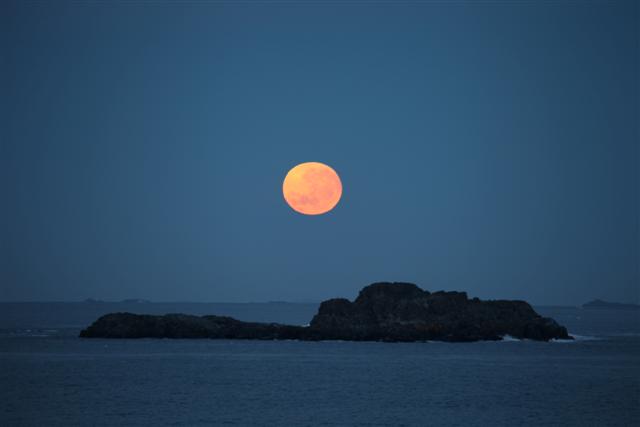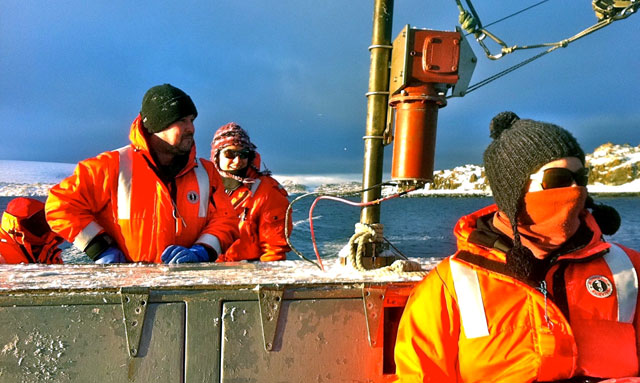|
Lighter side of microbesResearch into bacteria that get energy from the sun may shake up carbon cycle modelsPosted July 6, 2012
Microscopic bacteria in the ocean play a big role in the food web and carbon cycle, two interrelated processes that affect life on Earth. How abundant and active a particular subgroup of the microbes is in the Southern Ocean remains a mystery that a team of researchers is trying to unlock. Most ocean-dwelling bacteria feast on organic matter and are themselves a source of food for other organisms. They come in all sorts of flavors — including a group that can get energy from the sun, sort of like a plant, known as photoheterotrophs. “[Microbes are] bizarre compared to most of the organisms you think about,” conceded Matthew Cottrell Bacteria are mind-bogglingly abundant in the ocean. In more scientific terms, a liter of seawater would contain about 109 microbes, as in a billion per liter. Only a decade or so ago, scientists didn’t know much about photoheterotrophic bacteria. But they have come to discover that microscopic organisms sporting some sort of light-harvesting capability make up a quarter to half the bacteria in the surface waters of the ocean, according to Cottrell. That makes understanding their contributions to life and death as they relate to cycling of carbon in the ocean that much more important. “We may have to reformulate our view of the carbon cycle if photoheterotrophs really alter the way things happen,” Cottrell emphasized. Understanding the finer details about the ebb and flow of carbon is of particular significance as scientists seek to understand the effects of anthropogenic inputs into the cycle on the atmosphere, oceans and the rest of the biosphere. Part of the complication, Cottrell explained, is that photoheterotrophs don’t fit smoothly into how scientists generally divide the carbon cycle in the ocean between autotrophs like phytoplankton, which fix carbon and produce oxygen, and heterotrophs, which consume organic material and expel carbon dioxide. Photoheterotrophs are more on a sliding scale: One type known as aerobic anoxygenic phototrophic (AAP) bacteria were once thought to inhabit unique ecological niches, but now they likely account for 5 to 15 percent of bacteria in the ocean, Cottrell said. On the other hand, cyanobacteria, which use photosynthesis just like plants, were recently discovered to enjoy a bite of organic matter floating in the upper waters of the ocean. In general, bacteria process about half of the carbon in the ocean, according to Cottrell. At least in the lower latitudes. In the Arctic and Southern oceans, that number drops to about 5 percent. 
Photo Credit: Edward Quintanilla/Antarctic Photo Library
A full moon rises over an island near Palmer Station, which researchers visited at different times of the year to sample microbes under varying light conditions.
“Something is different in high latitudes,” Cottrell said. To learn more about those differences and figure out how the photoheterotrophs fit into the big picture, Cottrell and members of his research team made four trips to the U.S. Antarctic Program’s Palmer Station The Antarctic project is a follow-up to work that Cottrell and his co-investigator David Kirchman But that wasn’t the case. In fact, even cyanobacteria, which the scientists were surprised to find relative abundance in such high latitudes, seemed unfazed by the changing seasons and light. “They didn’t disappear in the winter, so when the ocean got covered by ice, we could still find the photosynthetic cyanobacteria in the water column under the ice. They were just as abundant as they were in the summertime,” Cottrell said. The conclusion at this time is that cyanobacteria and other photoheterotrophs make use of the organic material still in the water. “When the lights turn out, they switch,” Cottrell said. Does the same thing happen in the Southern Ocean? That remains to be seen. Cottrell, Kirchman and their students Monica Stegman and Mrinalini Nikrad are working on that problem. But the climate changes already under way in sensitive areas like the Antarctic Peninsula — where sea ice in the summer is nearly nonexistent and wintertime duration has dropped dramatically — are likely to affect the composition of the bacterial communities in the future. “We hope to get a better idea of what the photoheterotrophs are doing during winter. The shifts in microbial communities that occur in winter could be altered if there is less light being blocked by ice,” Cottrell said. “Bacteria have major influences on carbon and energy cycling in the ocean. That’s the main motivation for studying them in the ocean.” NSF-funded research in this story: Matthew Cottrell and David Kirchman, University of Delaware, Award No. 0838830
|



For USAP Participants |
For The Public |
For Researchers and EducatorsContact UsU.S. National Science FoundationOffice of Polar Programs Geosciences Directorate 2415 Eisenhower Avenue, Suite W7100 Alexandria, VA 22314 Sign up for the NSF Office of Polar Programs newsletter and events. Feedback Form |


